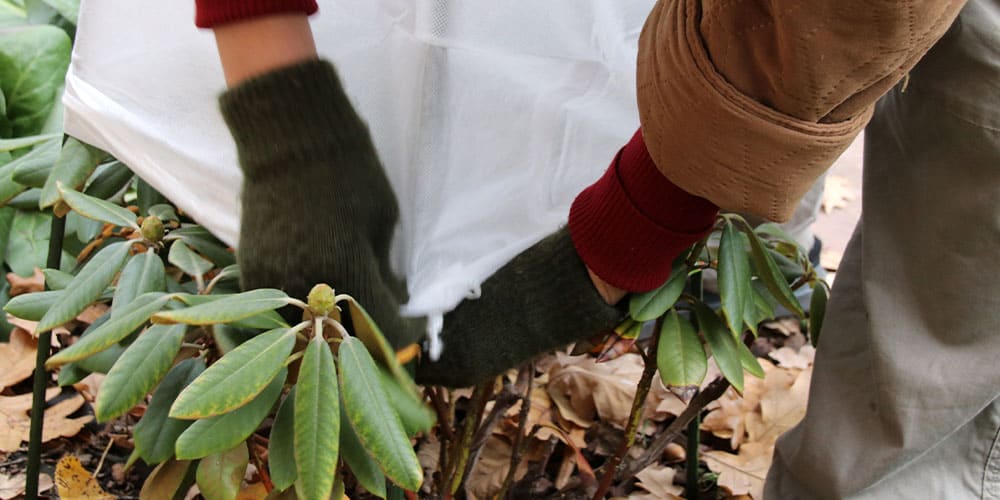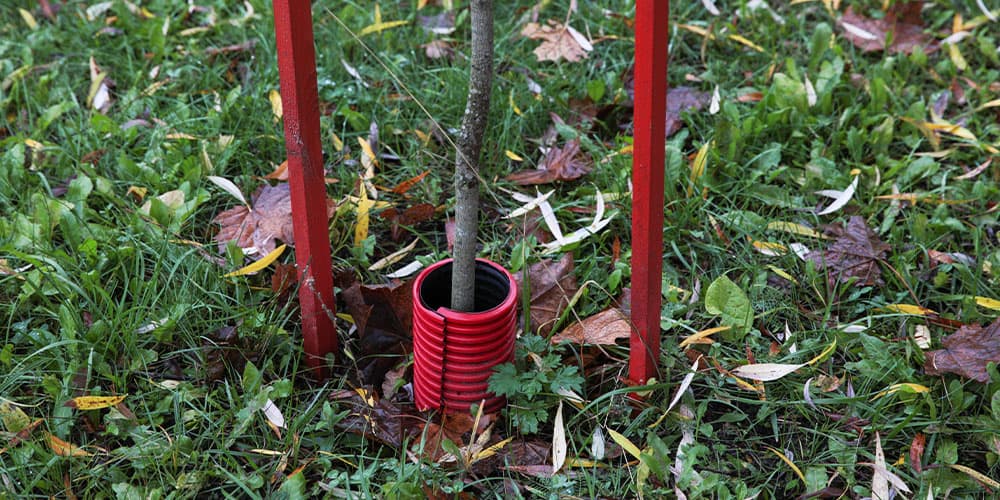Salt damage, winter burn, frost heaving, and hungry rodents are just a few of the challenges our trees have to contend with during the winter. Although most trees we grow in New Hampshire are experts at living through the cold months, we can still help them overcome seasonal challenges, so they thrive next year—here’s how!
Understanding Salt Damage
De-icers keep our roads and walkways ice-free during the winter, but they have an unfortunate consequence on nearby trees and plants. Traffic on roadways can spray salt water onto trees throughout the winter, causing evergreens to turn brown and die back in the spring or killing the new buds on deciduous trees. A cluster of dead twigs, or “witch’s broom,” on the end of deciduous branches is a telltale sign of damage from salt spray.

Besides being sprayed with salt water, trees also suffer from salt dissolved into snowmelt penetrating the ground; this can leech off roadways or come from de-icers you apply to your property. When a tree absorbs salt ions, it exhibits similar signs as drought damage, such as scorched and curling leaves, stunted growth, susceptibility to disease, and even death.
How to Prevent Salt Damage in Moultonborough
There’s no need to let your trees suffer from our de-icing practices. Here are several ways to help them avoid and overcome salt damage:
- Use Alternative De-icers: if possible, use coarse sand, gravel, or calcium chloride to prevent slipping on your walkways, and minimize or eliminate the use of sodium chloride.
- Pile Snow Away from Trees: when shoveling salty or dirty snow from your hardscapes, don’t pile it near any trees or gardens. Instead, shovel it somewhere where the snow can melt off your property, not into the root zone of trees.
- Erect a Barrier: set up a burlap screen, plastic fence, or snow fence in front of roadside trees that are subject to salt spray.
- Improve Drainage Around Trees: adjust the grade in your garden or landscape so salty snow melts away from your trees, not towards them.
- Flush the Soil in Spring: use water to flush away salt-affected trees, diluting any salty water and sending it deep into the ground, below the root zone.
- Be Mindful of Salt-Intolerant Trees: white pine, sugar maple, eastern hemlock, basswood, and spruce are intolerant of salt. Give them extra attention to prevent salt damage, and avoid planting them near roadways. Salt-tolerant species include birches, ashes, poplars, red oak, and red pine, but keep in mind that even though they’re more salt-tolerant, they can still be damaged by it.
How to Protect Trees From the Cold
Most trees native to New Hampshire or hardy to our growing zone can withstand our winter, but that doesn’t mean that winter doesn’t pose a challenge for them. Evergreens are vulnerable to winter burn, which happens when they lose too much moisture through their needles.
The freezing and thawing cycles of winter can also cause damage to roots, and there is the weight of the snow itself. Whether you have young trees you want to protect or trees that are prone to winter burn, here are some strategies to help your trees withstand the cold:
- Mulch the Roots: insulate the roots from fluctuating temperatures by mulching with bark mulch or wood chips. During extremely cold weather, you can pile extra snow around the roots of vulnerable trees. Remember to keep mulch 2 inches away from the trunk to prevent rotting.
- Wrap Vulnerable Trees: broadleaf evergreens, like rhododendrons or arborvitae, are particularly vulnerable to winter burn. You can place a frame around them and wrap it with burlap to prevent moisture loss. Evergreens exposed to sunny areas or prevailing winds also lose moisture more easily during the winter. If necessary, set up a burlap screen to protect them from desiccating wind and sun. Remember to remove any wrapping in the spring to prevent overheating.
- Water Evergreens in the Fall: water your evergreens regularly throughout October and November until the ground freezes to protect them against winter burn in the months ahead.
How to Protect Trees from Animal Damage
Rabbits and rodents pose a risk to trees over winter, especially young ones, which have softer bark. To prevent animals from girdling their trunks, wrap vulnerable trees with a plastic guard, metal mesh, or a metal cylinder. The cylinder should extend 2–3 inches below ground for mice and 18–24 inches above the snow for rabbits.
For more expert advice on protecting trees from salt damage and any challenges over winter, visit our garden center in Moultonborough, New Hampshire, and keep up-to-date with us on Facebook or Instagram.



